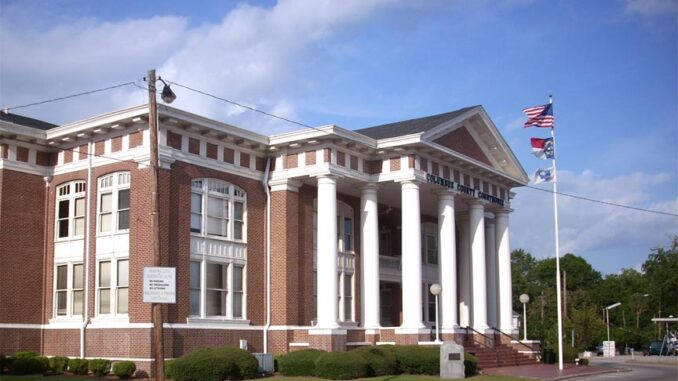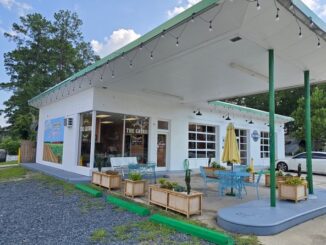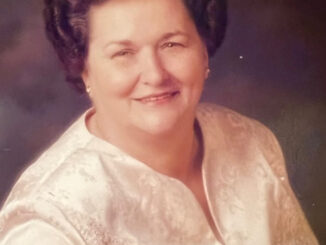
Renovation of the iconic Columbus County Courthouse is expected to wrap up by June, and officials are working out final details on how to use the structure.
The courthouse was built starting in 1914, and opened in 1915. At one point it housed all county offices as well as the courtroom. The courtroom was divided in the 1970s, and most of the non-judicial county offices moved to other locations.
The building was closed in 2015 after the annex with across the street was completed, and officials worked to find a use for the structure as well as funding for improvements. Rep. Brenden Jones obtained $4.5 million in state funding to help restore and upgrade the building, a process that has taken more than two years.
County Manager Eddie Madden met with stakeholders of the courthouse last week to discuss how to use the building, as well as how much security would be required — and where to find the funds for those positions.
The most prominent plan for the courthouse would use the now-restored single courtroom for Superior Court, civil sessions and special events and ceremonies. The remainder of the building would likely include an office for Chief Resident Superior Court Judge C. Ashley Gore, as well as administrative offices.
Madden said no office assignments have been made yet, but he anticipates that will change in the near future.
How to use the building has been a point of contention since the county announced plans to save the old building.
Construction problems, leaks and mold at the annex led to courts pursuing a writ of mandamus against the county administration. The writ was an official request for details on how the county commissioners planned to deal with the problems in the $11 million annex, including space. The plan accepted by then-Chief Judge Douglas Sasser placed a superior courtroom, administrative offices, and the Clerk of Court’s office in the downstairs of the courthouse.
Earlier this year, Sheriff Bill Rogers requested nearly $600,000 in additional funding for six deputies to provide security at the old courthouse. That number was later reduced to two deputies at a cost of $120,000 each, including equipment, benefits, and salaries.
Madden said in an email that he requested a meeting of shareholders in the courthouse project to determine exactly how much security would be required, and work out other details.
“After receiving the request (from Rogers), we called the meeting with the stakeholders to see if there were alternatives or ways to save money while fulfilling our obligations under state statute,” Madden wrote in an email. Landscape, signage, furniture, moving costs and other items were also on the agenda of the stakeholders meeting.
Among those in attendance were Commissioners Chair Ricky Bullard, Vice chair Buddy Byrd, senior county staff, the county finance officer and others.
Several attorneys who had attended a tour of the courthouse earlier in the week also attended to request additional room for attorney-client meeting spaces, Madden said.
Contrary to rumors that gained steam over the weekend, no office assignments have been made in the restored building. Chief District Court Judge Scott Ussery said he has not requested that the remainder of the old courthouse be reserved for private district judges’ offices. Currently, most judges have office space in the Dempsey Herring Administrative Building beside the annex.
“The district court judges are happy where we are,” Ussery said. “I have asked no one about moving over to the old courthouse. The county is our landlord – we will move wherever they tell us to, if they tell us to move.
“Before we moved anywhere, however, I would like to be able to inspect a potential new office, and make suggestions. But that hasn’t happened here, and I don’t anticipate it. District court judges don’t even have to have offices in every courthouse they serve. We’re supposed to be working in the courtroom.”
Ussery said that at the stakeholder meetings he attended, he had expressed his concerns about safety and convenience for people heading to court.
“People might get frustrated if they park a couple blocks away, go to the old courthouse, then walk back to the annex, then have to go back to the old courthouse to pay a fine or handle other business.”
Ussery also said that he had never asked for district court sessions to be held at the old courthouse.
“The volume of people that we see in traffic court or other cases wouldn’t be practical there,” he said. “We need to be in the annex, where we are having district court now.”
Clerk of Superior Court Jess Hill said he understood from the beginning of the project that the clerk’s office and cashiers would be in the old courthouse. When the court system completes the transition to the new eCourts system next year, he said, the courts will largely be paperless, and most payments will be made digitally.
“We will have a cashbox and cashier available in the clerk’s office in the old courthouse if and when that is necessary,” Hill said, “but soon that won’t be an issue. Look at the other courthouses that have already gone to eCourts—there are no folders, no sheafs, no papers in the courtrooms. Just computers.”
The clerk’s office is a natural choice for the old building, Hill said, since it is a landmark.
“People have been going there the whole time it was closed looking for court,” he said. “People will gravitate toward a building like that in the center of the street. We are an ambassador for the court system. The clerk’s office exists to help the taxpayers when they come to do business with the court system. Deputies are not going to have time to help citizens find the right building.”
Hill said he will abide by whatever decisions are made by the county officials when it comes to office assignments. At the same time, he said he understood the original plans approved in the writ of mandamus placed the superior court judge, the clerk’s office and special superior courtroom in the old courthouse. He said he is concerned about the potential costs and potential delays.
“Simply put, this is the county’s plan and for two and a half years I have relied on that plan through architectural drawings, meetings and planning. I will not support any plans that waste any money already spent, or cause any future tax burdens for our citizens,” Hill said.
Commission Chair Ricky Bullard said no plans have been finalized on whether to move the clerk’s office or any other division to the old courthouse.
“There have been some concerns expressed about pedestrian safety,” he said, “but these things have just been discussed, as part of the whole thing. We have to be concerned about where to provide security, what’s the most efficient and how best to manage the taxpayer’s dollars.”
Madden said that while the courthouse project started before his tenure as manager, he is looking forward to its return to service.
“We are excited to see the historic courthouse reopened,” he said. “It is truly a beautiful building and every citizen of the county will be pleased with the final results.”

























